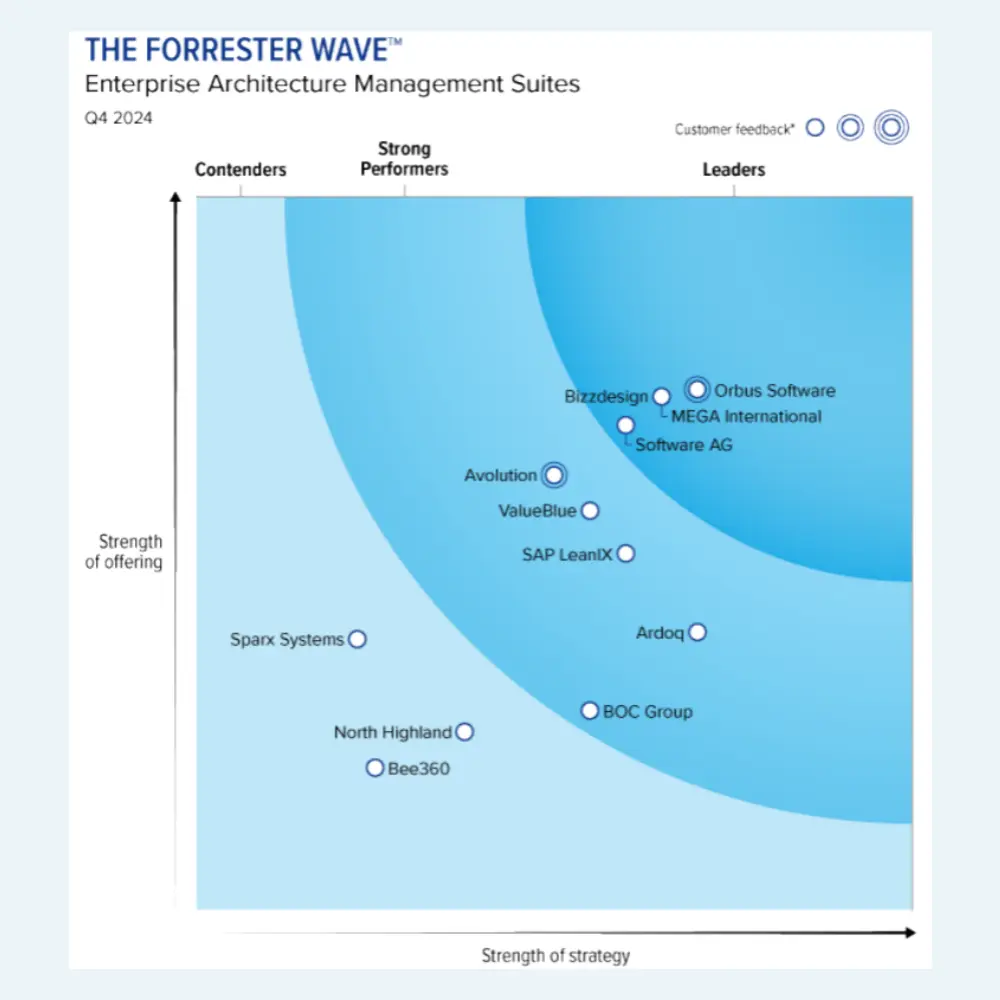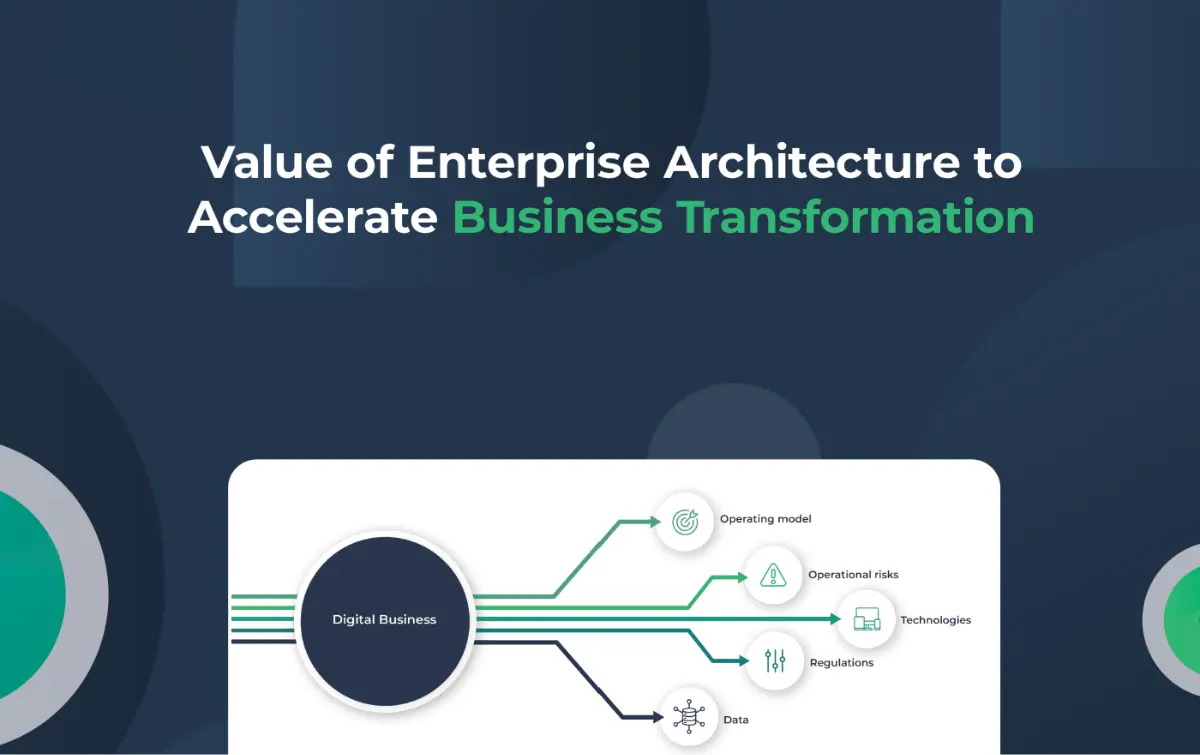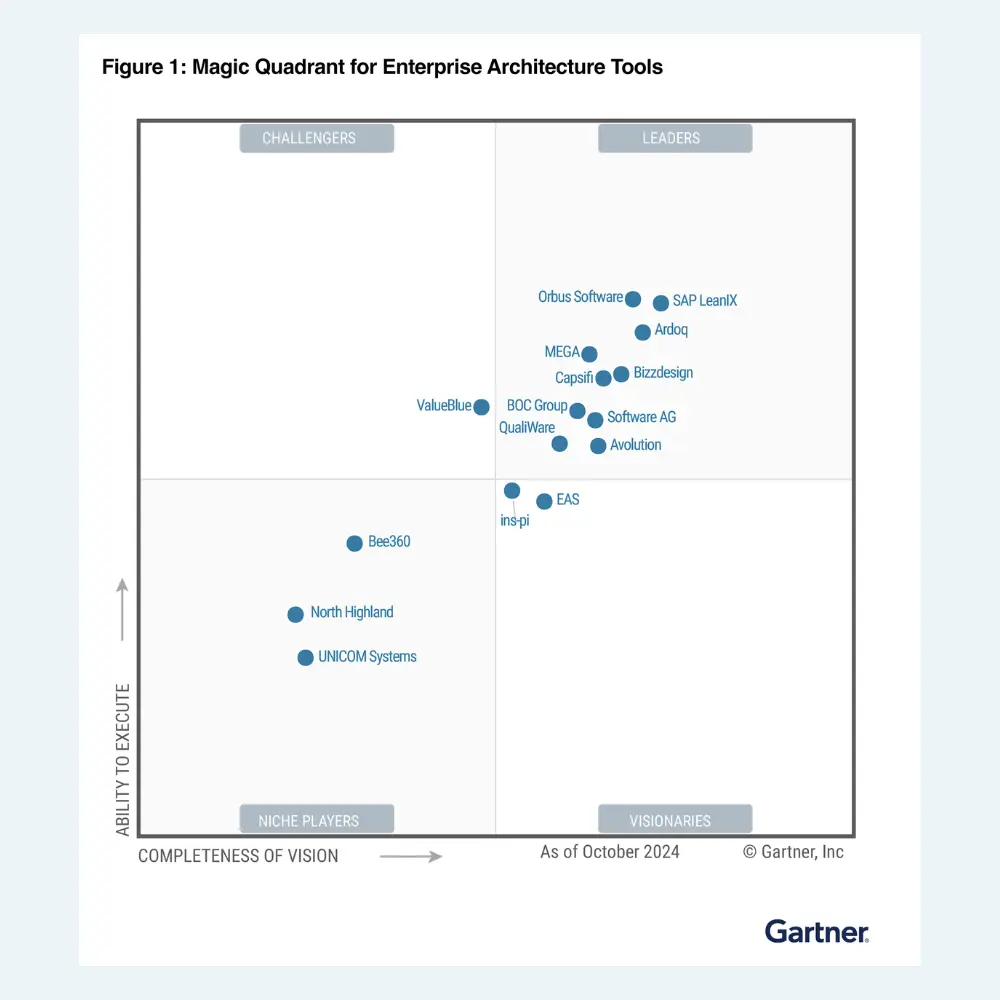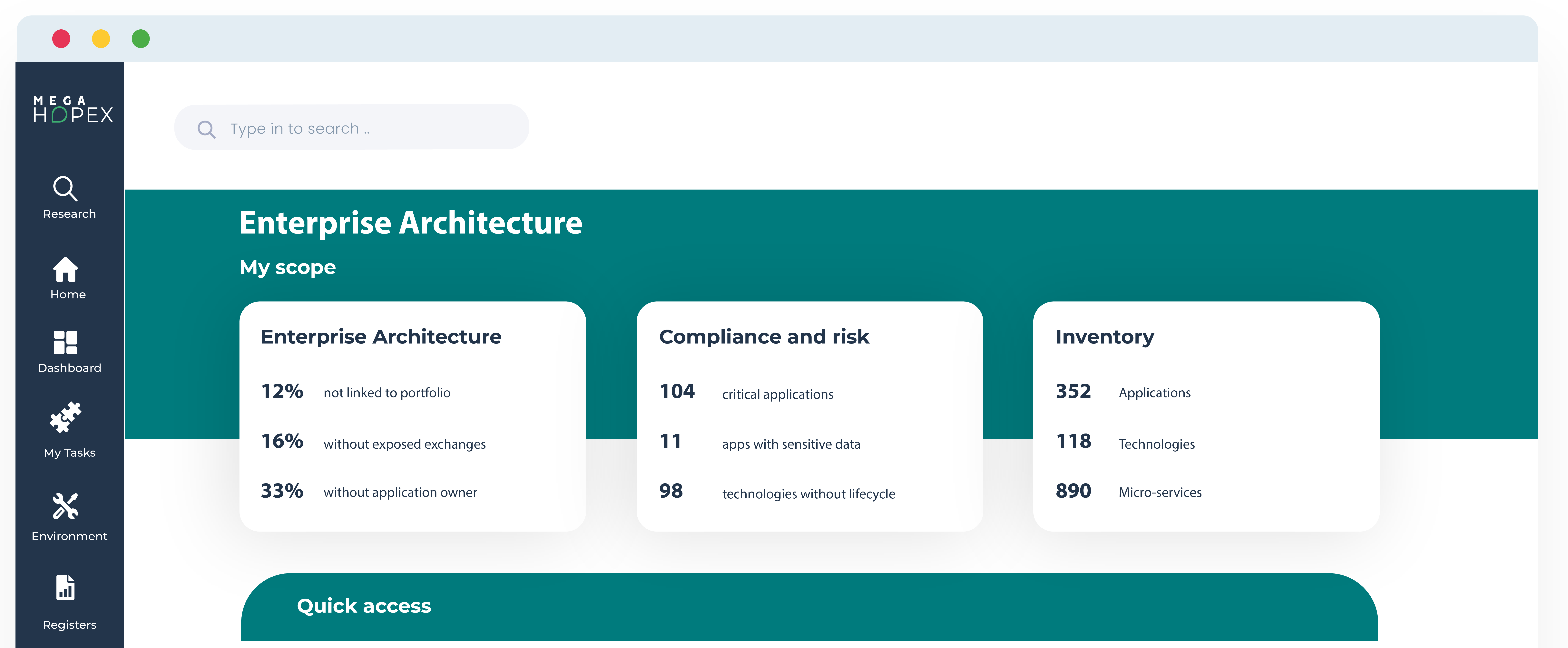
What is Enterprise Architecture (EA), and Why is it Important?
Enterprise architecture is a framework that helps businesses align their strategy, processes, and technology to achieve their goals. Essentially, it's a way to ensure that everyone is on the same page regarding the organization's vision and mission.
Companies can improve communication, increase efficiency, and reduce costs by having a clear enterprise architecture. But it's for more than just big corporations - even small businesses can benefit from having a solid enterprise architecture in place. In this article, we'll define what enterprise architecture is and why it's crucial.
The business ecosystem is getting complex. Every organization must transform to stay competitive, given multiple changes: customer expectations, new competitors, emerging technologies, regulation changes, and any world disruption. Enterprise Architecture (EA) is critical to supporting this transformation despite its complexity. By incorporating industry standards, EA helps organizations integrate different departments, systems, and processes. Next, we will explain how.
Definition of Enterprise Architecture
Enterprise Architecture (EA) is a practice that aims to align an organization's strategy and operating model. It outlines how an enterprise should organize and manage to achieve its objectives. As such, EA provides a blueprint to support the transformation of the enterprise—it is a journey and not a one-off project.
Why is enterprise architecture important?
Enterprise architecture is Critically vital for several reasons:
- It provides a common language and framework for businesses discussing IT initiatives. This common language allows different departments and business units to communicate more effectively with each other, which can help avoid costly misunderstandings.
- Enterprise architecture can help an organization align its IT investments with its business goals. By understanding how its various IT systems work together, an organization can ensure that its IT investments support its strategic objectives.
- Enterprise architecture can improve an organization's overall efficiency by helping it to identify and eliminate duplication and redundancy in its IT systems.
Purpose of enterprise architecture
EA aims to align business objectives with technology capabilities to achieve strategic goals. EA provides a holistic view of an organization's structure, processes, information systems, and technology infrastructure. The primary function of EA is to ensure that all the components of the enterprise, including business strategies, business processes, data architectures, and system architectures, are integrated, secure, and efficient.
By adopting EA, businesses can improve their decision-making, increase agility, reduce operational costs, and enhance their overall performance. EA also facilitates communication between different departments, providing a common language and framework for stakeholders to understand and collaborate on complex IT projects.
This approach can prevent duplication of IT systems or services that can potentially increase business costs, improve system resilience, and enhance agility. With enterprise architecture, digital transformation can be proactively and holistically led, leading to successful outcomes and fulfilling the desired business vision.
Therefore, organizations should prioritize enterprise architecture management to stay on track and achieve their digital transformation goals.
The Importance of Enterprise Architecture in Digital Transformation
Enterprise architecture is vital in guiding digital transformation efforts within an organization. It provides a detailed overview of the internal systems, processes, and data flows, enabling organizations to identify improvement areas and innovation opportunities.
By conducting thorough assessments of current IT infrastructures, enterprise architects can help identify gaps, redundancies, or inefficiencies that hinder digital transformation and recommend a roadmap for modernization. Moreover, enterprise architecture prevents duplication of IT systems or services that can potentially increase business costs, improve system resilience, and enhance agility.
Without enterprise architecture, a digital transformation journey can be disjointed and fail to meet business goals. Therefore, it is imperative for organizations undergoing digital transformation to prioritize enterprise architecture to ensure they stay on track and achieve the desired outcomes.
Key Components of Enterprise Architecture
EA provides methods to describe an entire organization's vision to analyze and design it, then plan and implement its evolution. 4 primary architecture layers ensure this completeness:
- Business architecture: This layer describes the company's strategy, the services offered, the organization, and the business capabilities required to deliver the services.
- Application architecture: This layer defines the enterprise's application portfolio, integration, and how these IT assets support the processes and services delivered.
- Information Architecture: This layer defines the enterprise's information requirements and data model and helps ensure data is managed to support business needs.
- Technology architecture: This layer identifies the technologies (software and hardware) that support the applications and data and understand how they are deployed.
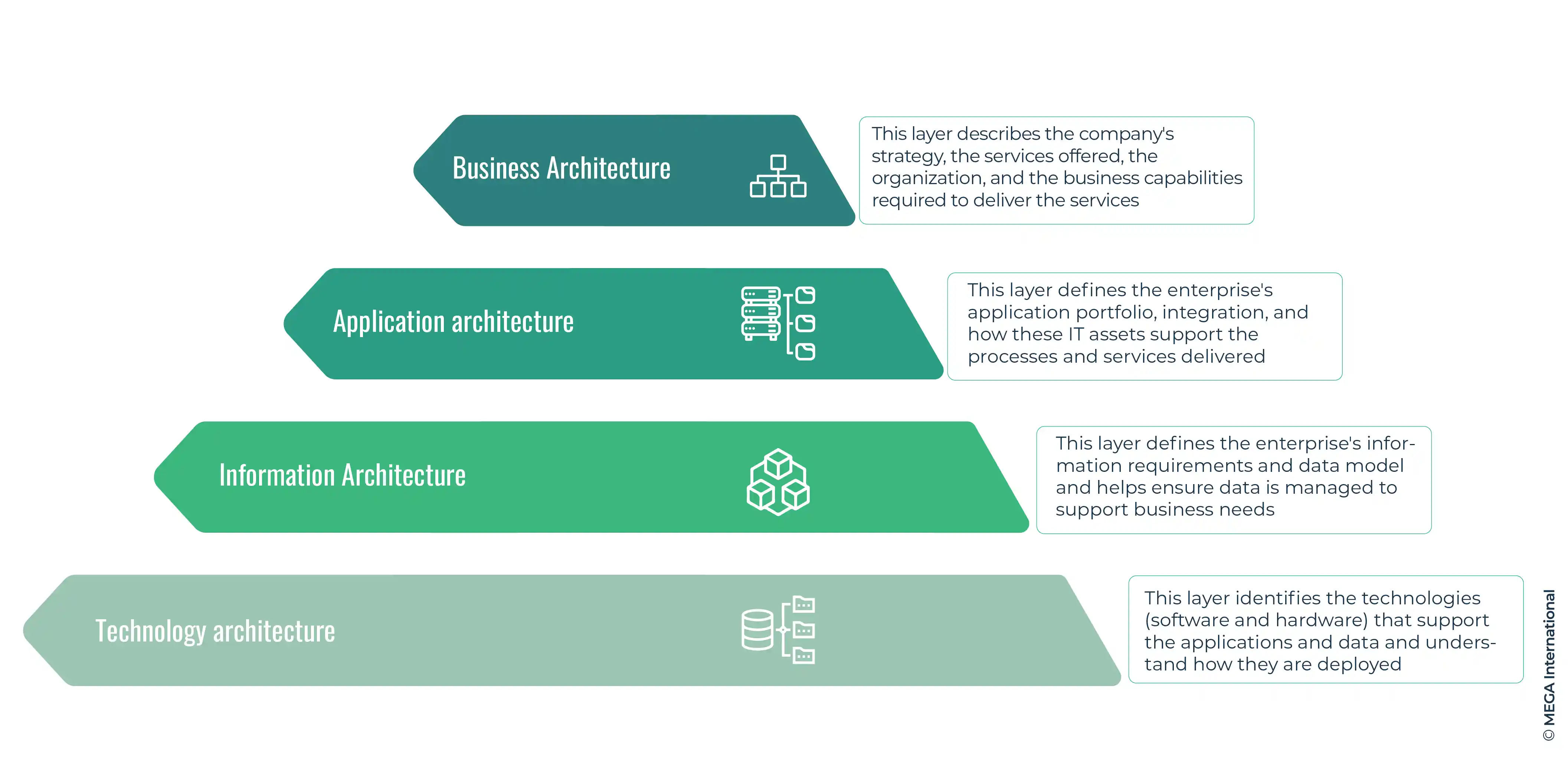
Therefore, each concept is specific to a layer. Still, it can be linked to concepts from other layers (e.g., a business capability may be supported by one or several applications, each relying on numerous technologies), and precisely analyzing these relationships enables identifying the impact of change.
For example, what happens if a server deployed in the organization goes down? What would be the consequences for the business?
This impact analysis will help identify risks and anticipate problems, helping to design better and plan the company's transformation.
Learn about Elements of Business architecture vs. Enterprise Architecture.
Enterprise architecture benefits
EA is its ability to provide recommendations to business and IT teams to adapt current processes and IT assets, ensuring they are aligned with the company's strategy.
Enterprise Architecture tool makes it possible to implement actions to reduce the risks generated by these drifts and offers more concretely the following benefits:
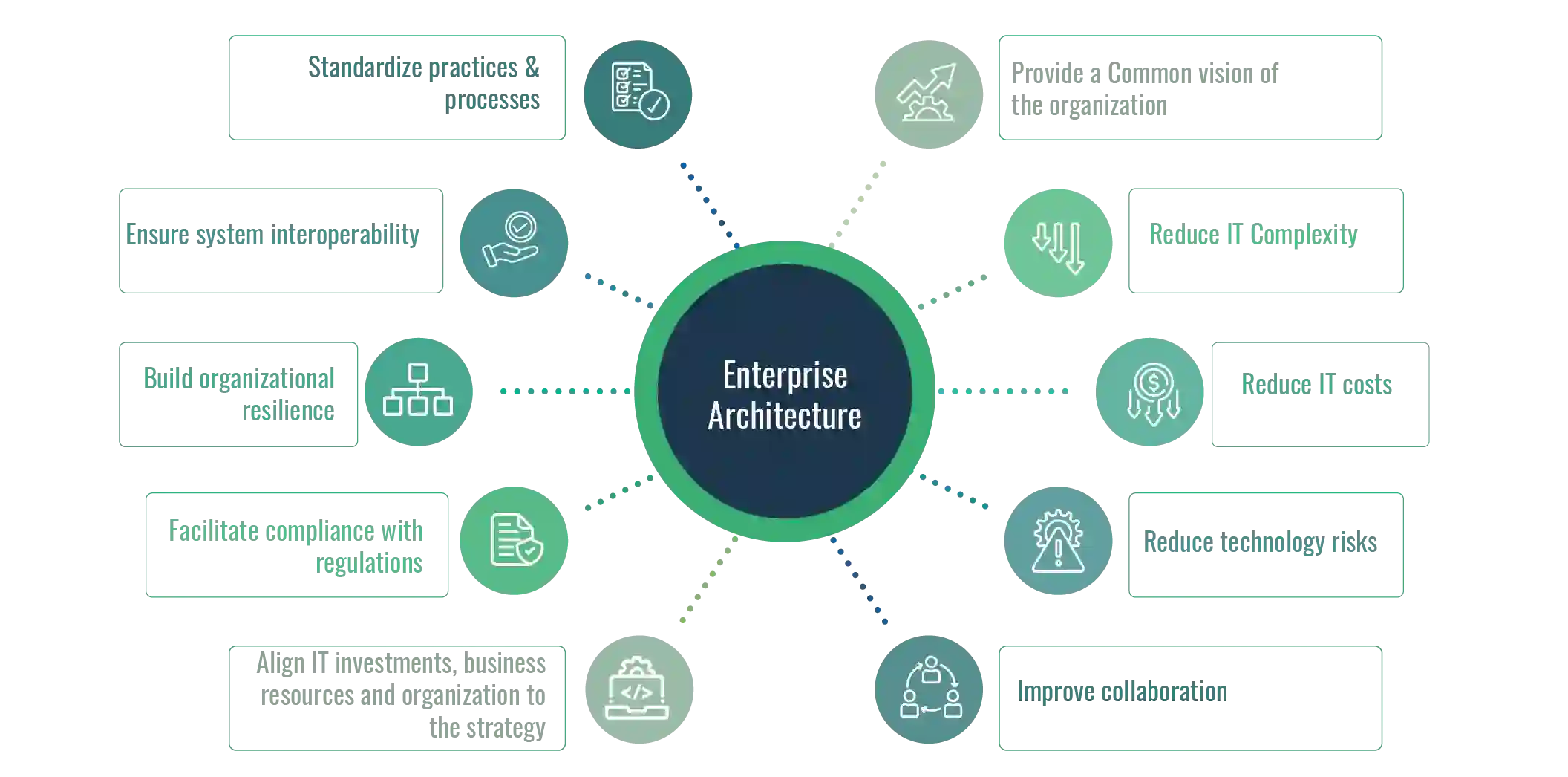
- Provide a shared vision of the organization.
- Reduce IT complexity and facilitate the evolution of Information Systems.
- Reduce IT costs by removing redundancies and breaking organizational silos.
- Improve collaboration between business and IT teams.
- Align IT investments, business resources, and organization to the company's strategy.
- Facilitate compliance with regulations.
- Build organizational resilience.
- Ensure system interoperability.
- Standardize practices and processes.
Enterprise Architect's Role
Enterprise architects analyze operating models (structures, processes, resources...) to ensure they effectively and efficiently align with business goals.
The role of enterprise architects is to ensure that these structures and processes are agile and durable, allowing them to adapt quickly and support significant changes. They usually report to the CIO (Chief Information Officer) or other IT managers and may work as CTO (Chief Technology Officer), software engineer, development manager, or CIO.
An undergraduate degree in computer science, information technology, or a related field, as well as at least ten years of experience in IT or a related field, are required to become an enterprise architect.
You should also have hands-on experience with computer systems, mainframes, and other architectural techniques. To succeed, enterprise architects must have various soft skills, including communication, problem-solving, critical thinking, leadership, and teamwork.
Enterprise architecture stakeholders and their concerns
Enterprise Architecture (EA) aims to describe an organization's complexity, so its scope is vast. Depending on the intended objective, many organizational roles may be involved in the EA processes.
- Enterprise Architects: provides architecture services that transform the operating model to align with the strategy.
- Portfolio Managers: responsible for maintaining and rationalizing application or technology portfolios
- Business Architects: define business models and capability models, and ensure that value streams are aligned with customer expectations and journeys
- Solution Architects: design technology solutions to meet business needs, typically at the application, service, and infrastructure levels
- Security Architects: verify that newly designed architecture complies with the organization's security policy
- Business Analysts: refine and optimize processes for general improvements or regulatory reasons, as well as define candidates for automation
- Chief Data Officer/Information Architects: manage and design where data and information are used, moved, or stored across the enterprise and support intelligence, regulatory, privacy, and data science activities
- Risk/Compliance Managers: responsible for assessing risk exposure and regulatory compliance of the current or future state of the enterprise
CIO (Chief Information Officer) and CISO (Chief Information Security Officer) are often Enterprise Architecture's leading sponsors.
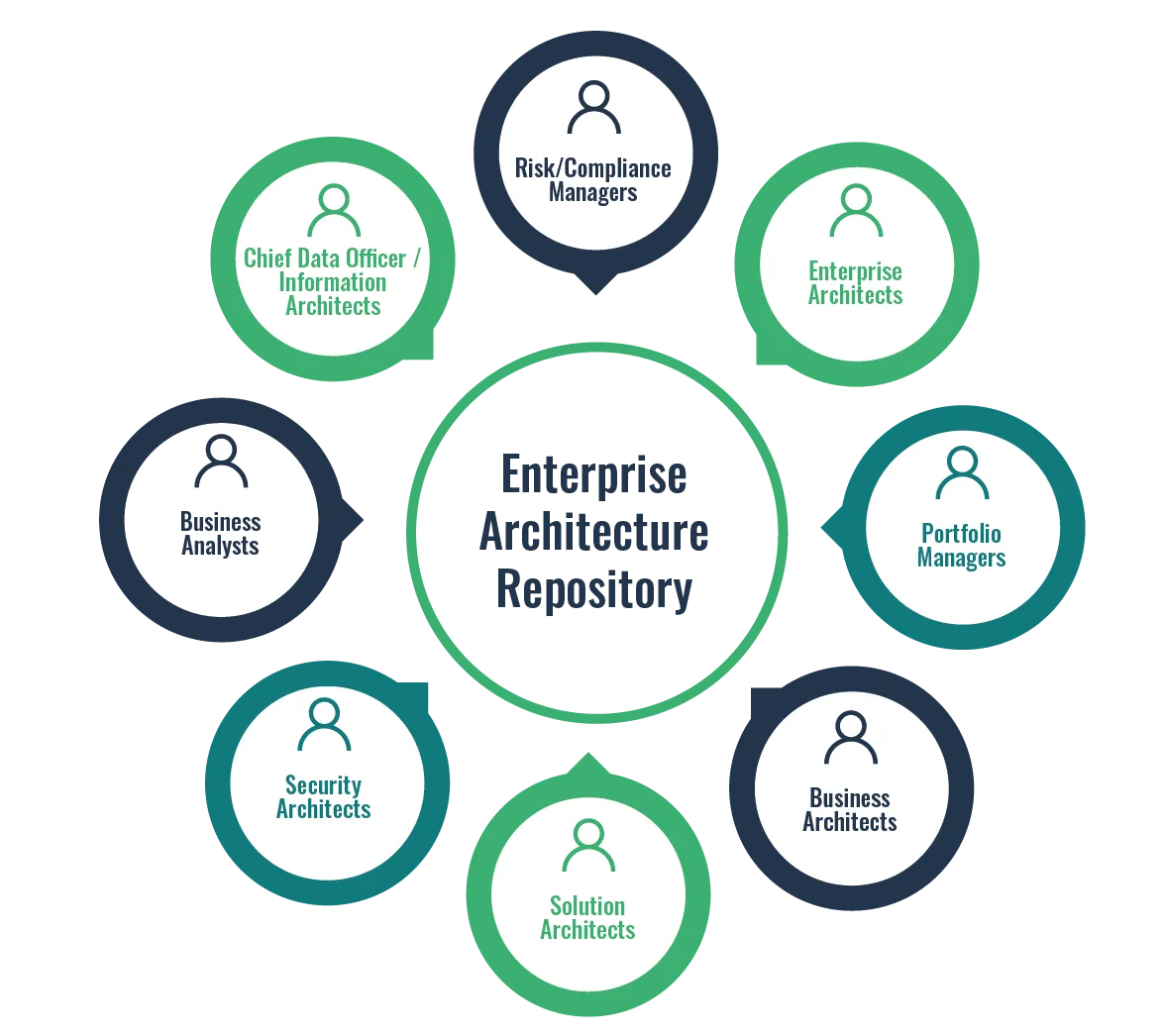
What enterprise architecture does in your role for IT operations?
For each of these roles, Enterprise Architecture provides answers to their specific questions:
(People with IT focus)
- Solution Architect: How should I integrate a new solution into the IT landscape? What are the authorized technologies in the company? Should I deploy this application in the cloud or on-premises?
- Security Architect: Does the new solution respect security principles? What are the threats and vulnerabilities of each application?
- Developer: Which microservices should I leverage? What are the current application integrations?
- CTO (Chief Technology Officer): What is the technology roadmap? What are the risks coming from technology obsolescence? How do I mitigate these risks?
- CIO: How can we prioritize our IT investments to support the company's strategic priorities? How should we transform our IT landscape? In which application should we invest? Which applications should be removed? What is the IT roadmap? What is the cost of our IT landscape, and how can we reduce IT costs?
(People with Business Focus)
- Business Analyst: Which applications support this process? How should we automate this process?
- Risk Officer: What are the risks to IT assets (cybersecurity, compliance)?
We must implement EA appropriately to get the correct answers to all these questions.
This implementation can be tedious without guidance, which is why Enterprise Architecture frameworks can help accelerate the performance of an Enterprise Architecture practice.
Enterprise architecture framework
Get a complimentary copy: 2024 Gartner® Magic Quadrant™ for Enterprise Architecture Tools
Enterprise architecture frameworks are a set of structures, processes, and tools that support the management and implementation of an enterprise architecture. The framework ensures consistency and reliability; it can be a natural accelerator for people who want to set up an Enterprise Architecture practice quickly without spending too much time defining each concept and its relationships.
Several EA frameworks exist, each with unique features that distinguish it from the others. Some of the most popular enterprise architecture frameworks include The Zachman Framework, The Open Group Architecture Framework (TOGAF), the Federal Enterprise Architecture Framework (FEAF), and The Global Enterprise Architecture Organization (GEAO).
Each framework has a specific approach, methodology, and process to help organizations identify, design, and execute an effective enterprise architecture. Learn more about the enterprise architecture framework's principles and best practices.
Enterprise Architecture models and diagrams
EA aims to describe an organization's different perspectives to understand, analyze, and transform it.
Modeling is vital to explain this complexity and communicate it to all stakeholders. Modeling is necessary to understand complex systems from multiple perspectives; it is also a perfect solution to share with non-expert people.
Architecture relies on models and diagrams to address several key objectives:
For Enterprise Architecture:
- A business motivation model represents the enterprise strategy and visualizes enterprise objectives.
- Business Model Canvas to get a high-level, comprehensive view of the strategic items required to bring a product to market successfully
- Business capability maps to clearly understand the enterprise's capabilities and how IT assets support them.
- Customer journey map to understand how customers interact with the organization and their satisfaction level.
- Process/Value stream maps to visualize how products and services are delivered and analyze the value delivered to customers.
- Enterprise transformation roadmap and IT roadmap to visualize and communicate how business and IT projects are planned over time.
For Solution Architecture:
- Solution environment model to define the solution's integration into the existing IT landscape.
- Application deployment model to describe how technical components of an application must be deployed to avoid potential pitfalls
- Technical infrastructure map to define the technical infrastructure required to support the deployed solution
Use cases and examples for Enterprise Architecture
Enterprise Architecture's vast scope covers multiple use cases to help decision-makers manage changes.
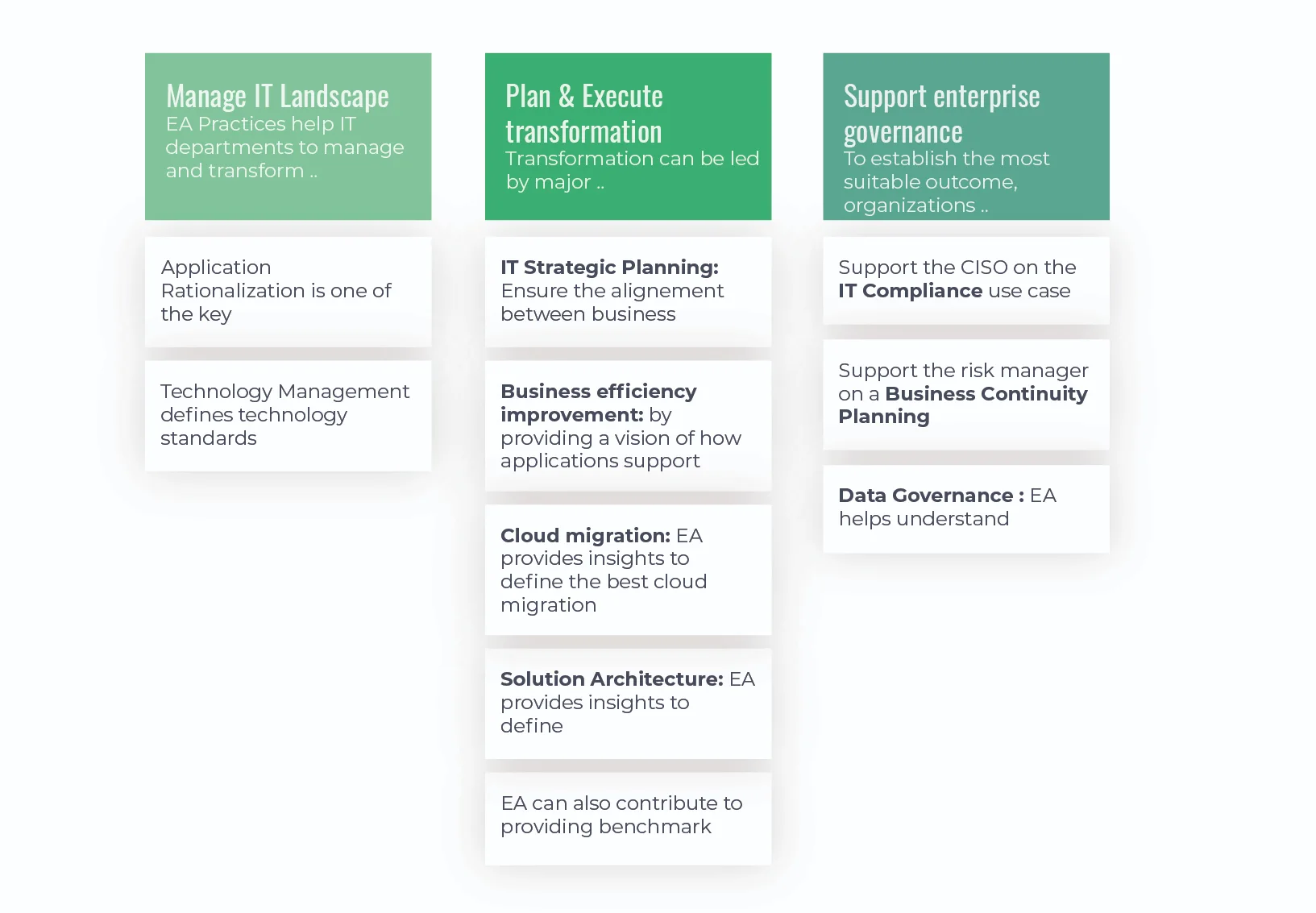
IT landscape management
EA practices help IT departments manage and transform the IT assets of the organization by bringing visibility, impact analysis, and recommendations for two primary use cases:
- Enterprise Architecture is a critical use case for application rationalization. It aims to analyze the IT landscape, detect functional redundancies, identify optimizations, and reduce costs. EA provides clear visibility of existing applications, their link with business capabilities, and their costs, thus enabling organizations to gain insights and make informed decisions for application rationalization.
- Technology management actively defines technology standards, establishes processes to evaluate and acquire technologies, and mitigates the risk of obsolescence by actively managing application and technology lifecycles and proactively detecting potential conflicts.
Plan and execute the transformation.
Organizational changes such as mergers and acquisitions, introducing a new product/service, or modernizing the IT landscape (e.g., moving to the cloud or shifting from a monolith architecture to microservices) can lead to transformation. EA supports business transformation through the following use cases:
- IT strategic planning: ensure the alignment between business needs and IT investments
- Business efficiency improvement: by providing a vision of how applications support processes, EA helps business analysts better understand why some strategies are not performing as expected or are failing to match customers' expectations.
- Cloud migration: EA can identify the best cloud migration strategy by providing insights on which applications should migrate to the cloud and how.
- Solution architecture defines the required architecture for a new IT solution from different perspectives (business, functional, application, technical, and security)
- EA can also contribute to providing benchmarks.
Build resiliency
Organizations can best support enterprise and data governance by combining risk management functions to establish sustainable outcomes.
- Support the CISO on the IT compliance use case by providing an up-to-date IT inventory and regulatory controls to help run regular compliance checks.
- Support the risk manager on a Business Continuity Planning use case by providing a ready-to-use process and application inventory to base business impact analysis upon
- Data governance: EA helps understand the context in which data is used and for what purposes (applications and processes) to improve data quality and ensure data compliance
Enterprise Architecture best practices
Enterprise architecture best practices are essential for businesses to ensure that their IT infrastructure supports their goals and objectives.
A comprehensive enterprise architecture framework can help organizations streamline their processes, reduce duplication of efforts, and optimize their systems. The first best practice clearly understands the business's goals, objectives, and strategies.
The second is to align the architecture with business objectives. The third is to adopt a flexible, scalable, and open architecture that can accommodate changes in business needs. Fourth, the overall cost-effectiveness of the enterprise architecture must be evaluated.
Fifth, communicate the enterprise architecture framework to all stakeholders to ensure everyone is on the same page. Lastly, evolve the architecture framework to meet the organization's ever-changing needs. By adopting these best practices, businesses can develop a robust enterprise architecture supporting long-term success.
The importance of Enterprise architecture tools and software
Enterprise Architecture is critical for proactively and holistically leading enterprises toward their desired business outcomes. Identifying and analyzing enterprise information using architecture principles is vital for every organization to achieve success. EA delivers value by providing data-driven insights that help architects make informed decisions quickly and confidently.
To manage the complexity of modern enterprises effectively, the use of EA tools and software is essential. While Microsoft Excel and PowerPoint can be useful for corporate architectural planning, they may only sometimes suffice to meet the objectives of an enterprise architecture practice in complex contexts. Hence, developing advanced Enterprise Architecture strategies must use more robust third-party tools and software that apply architectural principles and practices.
EA software provides a single repository facilitating communication and alignment across the organization. Enterprise layers speed up routine tasks and provide data-driven insights to make decisions quickly and confidently. These tools also offer modeling capabilities that allow architects to design all necessary architectural descriptions.
Furthermore, the organization can share these results through collaboration features such as workflows, alerts, and notifications. More people must be involved in the EA process because maintaining an EA repository requires collaboration. EA tools automate and accelerate value creation for architects, allowing them to focus on the most valuable activities, such as data analysis and architecture definition.
Features like automatic discovery can automate less-valuable activities like data collection, saving time and minimizing tediousness. Advanced algorithms in next-generation EA solutions also accelerate business decision-making by automatically analyzing the content of the EA repository, providing data-driven insights such as recommendations for application rationale or conflict detection for technology obsolescence management.
Organizations should follow a pragmatic, use-case-based approach to establish an enterprise architecture approach that quickly provides value to stakeholders. They should focus on tangible outcomes while developing a solid foundation for business transformations. In this approach, EA management should encompass hardware and software to ensure that every organization can effectively achieve its desired business outcomes.
Summary
Enterprise architecture is an essential aspect of business strategy that integrates all aspects of the organization's structure, including its people, processes, and technology. By providing a holistic view of the organization, enterprise architecture enables businesses to make informed decisions and optimize their technology investments. Therefore, organizations must prioritize enterprise architecture in their business strategy to ensure long-term success and competitive advantage in today's rapidly evolving business environment.
FAQs
Enterprise architecture refers to the overall design and structure of an organization's IT systems, applications, and processes. It involves a strategic approach to aligning technology with business objectives and creating a blueprint for the organization's technology infrastructure. Enterprise architecture ensures systems and processes are efficient, effective, and cohesive while allowing scalability and flexibility in changing business needs.
Enterprise architecture is a strategic planning process that enables organizations to align their business goals with technology investments. Enterprise architecture provides a holistic view of an organization's IT infrastructure and ensures that technology investments support business objectives. By defining a clear future state architecture, enterprise architecture enables organizations to make informed decisions about investing in technology to support their long-term strategy better.
Enterprise architecture creates a blueprint or framework that outlines the different components of an organization's IT architecture, how they relate to one another, and their role in achieving its overall objectives. This blueprint guides decision-making when selecting and implementing technology solutions, ensuring they are integrated and effectively support the organization's goals. Enterprise architecture also involves ongoing monitoring and evaluation to ensure that the IT infrastructure remains aligned with the organization's objectives and adaptable to changes in the business environment.
Enterprise architecture tools are software programs used to design and implement an organization's enterprise architecture. They enable users to model and document the components, processes, and relationships of an enterprise's technology infrastructure, business processes, and information systems. These tools can help architects, IT professionals, and business leaders to align the organization's operations with business goals, ensure regulatory compliance, manage risks, and optimize resources. Examples of enterprise architecture tools include:
- Modelling and visualization software.
- Data management tools.
- IT portfolio management systems.
- Business process modelling software.
The value of Enterprise Architecture to accelerate business transformation
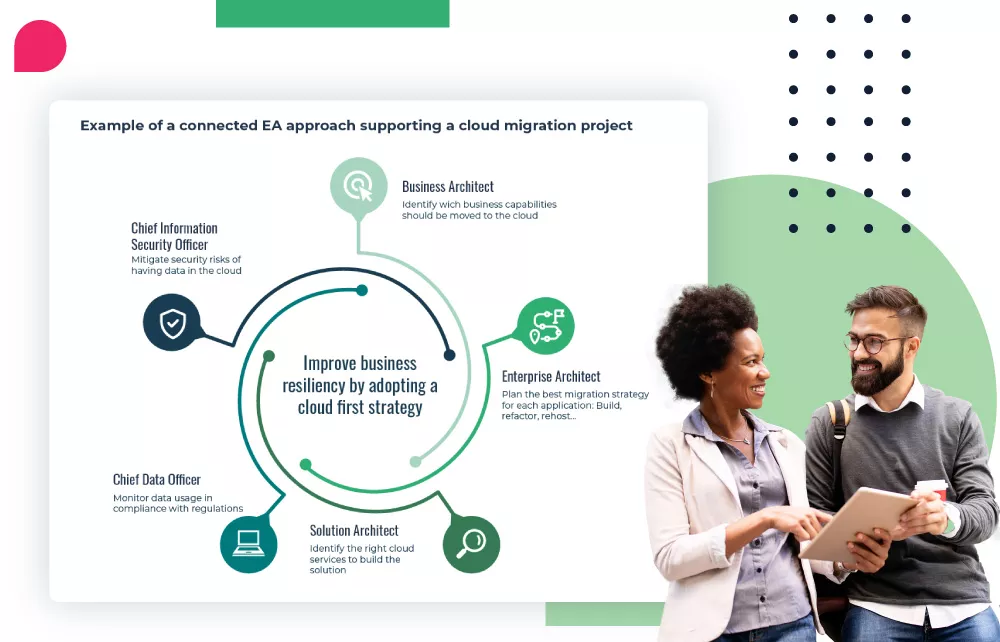
Access this white paper to learn:
- The evolution of the enterprise architecture practice
- How to Deliver Value through a Connected Enterprise Architecture Practice
- Strategies for Adopting a Business-Outcome-Driven Approach
- How to Use Data-Driven Tools to Enhance Your Enterprise Architecture Connectivity
Enterprise Architecture Related Content
Shift from a documentation tool to an operational tool and accelerate business transformation
MEGA HOPEX for Enterprise Architecture
Request a demonstration of HOPEX for EA, and see how you can have immediate value of your projects.










